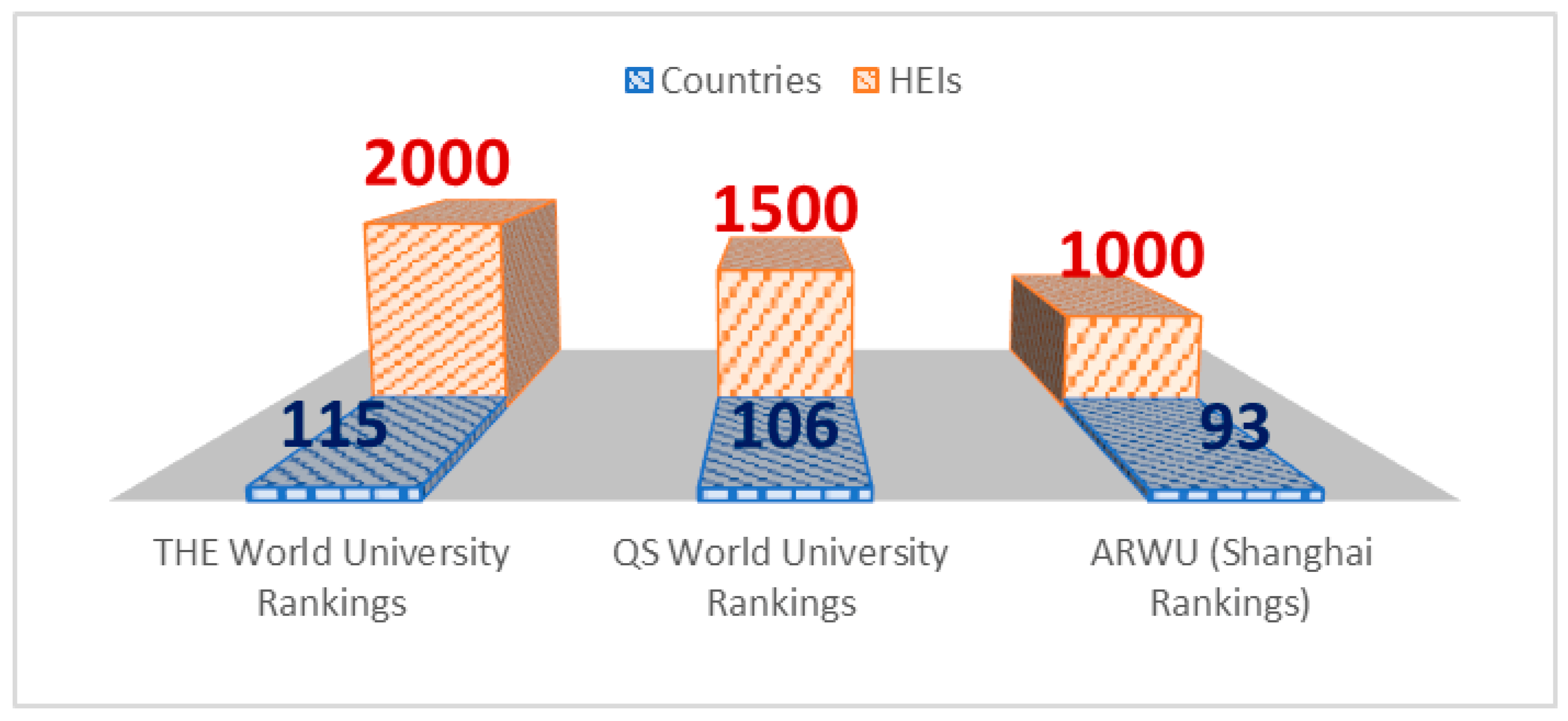The Role of Saudi Arabian Higher Education Institutions in Sustainable Development: Participation, Framework Alignment, and Strategic Insights
Abstract
1. Introduction
2. An Overview of Sustainability-Focused Global Rankings
Times Higher Education Impact Rankings (THE IR)
3. Methodology
3.1. Data Acquisition and Preprocessing
3.1.1. Data Source
3.1.2. Data Preparation
- Missing data, Duplicates, and Outliers: None of the data values were found to be missing, redundant, or extreme.
- Inconsistencies: Each participating HEI in THE IR is evaluated only for four SDGs with SDG-17 as mandatory. Therefore, we standardized yearly data as per total SDGs covered, and participation is indicated by a tick mark. Rows and columns in Table A1, Table A2, Table A3, Table A4, Table A5 and Table A6 represent the HEI name and targeted SDG, respectively, to avoid possible inconsistencies.
3.1.3. Data Quantification
3.2. Descriptive Statistical Analysis
4. Participation and Performance of Saudi Arabian HEIs in Relation to UN-SDGs in THE Impact Rankings
4.1. Top 100 Ranked HEIs of Saudi Arabia in THE IR
4.2. UN-SDGs Coverage by B1-Ranked HEIs of KSA
4.3. Key Findings and Conclusion for Hypothesis 1
5. Assessment of Framework Alignment in Saudi Arabian HEIs
5.1. Alignment with an International Framework: EUA Framework
5.2. Alignment with a National Framework: UN-KSA Cooperation Framework (2022–2026)
5.2.1. Strategic Priority Area 1: People
5.2.2. Strategic Priority Area 2: Planet
5.2.3. Strategic Priority Area 3: Prosperity
5.2.4. Strategic Priority Area 4: Peace, Partnership, and Other Cross-Cutting Issues
5.3. Key Findings and Conclusion for Hypothesis 2
- (i)
- Low Priority (percentage coverage of less than 25)
- (ii)
- Moderate Priority (percentage coverage of 26–50)
- (iii)
- High Priority (percentage coverage of more than 50)
6. Comparative Analysis of UN-SDG Attainment: Insights from the EUA and UN-KSA Frameworks and the Saudi Arabian SD Report (2024)
6.1. Comparison of EUA Framework Insights with the Saudi Arabian SD Report (2024)
6.2. Comparison of UN-KSA Framework Insights with the Saudi Arabian SD Report (2024)
6.2.1. SPA-1
6.2.2. SPA-2
6.2.3. SPA-3
6.2.4. SPA-4
6.3. Key Findings and Conclusion for Hypothesis 3
7. Cluster Identification of HEIs in Relation to UN-SDGs Coverage
7.1. Key Insights and Strengths
7.1.1. Fully Aligned Groups
7.1.2. Closely Aligned Groups
7.1.3. Diversified Groups
7.1.4. Focused Groups
- HEIs such as AFU and UQU excel in SDG 3, 4, and SDG 9.
- HEIs such as KSAU-HS, PSAU, UOHB, and BMC also show strong focus on SDGs 3, 4, and 5.
7.1.5. Consistently Performing HEIs
- AFU, consistently active for six years, covering SDGs 3, 4, and 9.
- UQU, consistently active for four years, covering SDGs 3, 4, and 9.
- PSU, consistently active for four years, covering SDGs 5, 8, and 16.
- UBT, consistently active for four years, covering SDGs 5, 8, and 10.
7.2. Proposed Grouping of HEIs for Enhanced and Advanced Coverage of UN-SDGs
Funding
Institutional Review Board Statement
Informed Consent Statement
Data Availability Statement
Acknowledgments
Conflicts of Interest
Abbreviations
| HEIs | Higher Educational Institutions |
| UN-SDGs | United Nations Sustainable Development Goals |
| THE IR | Times Higher Education Impact Rankings |
| EUA | European Union Association |
| UN-KSA | United Nations Sustainable Development Cooperation Framework with the Kingdom of Saudi Arabia 2022–2026 |
| SDR | Sustainable Development Report |
| OECD | Organization for Economic Co-operation and Development |
| INES | Indicators of Education Systems |
| SPA | Strategic Priority Area |
| STAR | Sustainability Tracking, Assessment, and Rating System |
| HESI | Higher Education Sustainability Initiative |
| UIGWUR | UI GreenMetric World University Ranking |
| SET4HEI | Sustainability Evaluation Tool for Higher Education Institutions |
| EAUC | Environmental Association for Universities and Colleges |
| LIFE | Learning in Future Environments |
| AASHE | Association for the Advancement of Sustainability in Higher Education |
Appendix A
| Achieved Bands | HEIs Name | UN SDGs Covered | ||||||
|---|---|---|---|---|---|---|---|---|
| 3 | 4 | 5 | 9 | 10 | 11 | 17 | ||
| 54th | KAU | ✔ | ✔ | ✔ | ✔ | |||
| 101–200 | AFU | ✔ | ✔ | ✔ | ✔ | |||
| KSU | ✔ | ✔ | ✔ | ✔ | ||||
| Percentage Coverage by Participating HEIs | 67 | 33 | 68 | 67 | 33 | 33 | 100 | |
| Achieved Bands | HEIs Name | UN SDGs Covered | |||||||||
|---|---|---|---|---|---|---|---|---|---|---|---|
| 1 | 2 | 3 | 4 | 5 | 8 | 9 | 10 | 16 | 17 | ||
| 101–200 | KAU | ✔ | ✔ | ✔ | ✔ | ||||||
| 401–600 | AFU | ✔ | ✔ | ✔ | ✔ | ||||||
| PNU | ✔ | ✔ | ✔ | ✔ | |||||||
| 601+ | KKU | ✔ | ✔ | ✔ | ✔ | ||||||
| QU | ✔ | ✔ | ✔ | ✔ | |||||||
| Percentage Coverage by Participating HEIs | 20 | 20 | 40 | 60 | 40 | 40 | 40 | 20 | 20 | 100 | |
| Achieved Bands | HEIs Name | UN SDGs Covered | ||||||||||||
|---|---|---|---|---|---|---|---|---|---|---|---|---|---|---|
| 1 | 3 | 4 | 5 | 6 | 7 | 8 | 9 | 10 | 12 | 14 | 16 | 17 | ||
| 27th | PNU | ✔ | ✔ | ✔ | ✔ | |||||||||
| 46th | KAU | ✔ | ✔ | ✔ | ✔ | |||||||||
| 101–200 | PMU | ✔ | ✔ | ✔ | ✔ | |||||||||
| 201–300 | UM | ✔ | ✔ | ✔ | ✔ | |||||||||
| 301–400 | AFU | ✔ | ✔ | ✔ | ✔ | |||||||||
| KKU | ✔ | ✔ | ✔ | ✔ | ||||||||||
| UQU | ✔ | ✔ | ✔ | ✔ | ||||||||||
| 401–600 | PSU | ✔ | ✔ | ✔ | ✔ | |||||||||
| 601–800 | IABFU | ✔ | ✔ | ✔ | ✔ | |||||||||
| KFU | ✔ | ✔ | ✔ | ✔ | ||||||||||
| 801–1000 | KFUPM | ✔ | ✔ | ✔ | ✔ | |||||||||
| QU | ✔ | ✔ | ✔ | ✔ | ||||||||||
| Percentage Coverage by Participating HEIs | 8 | 50 | 42 | 33 | 17 | 25 | 50 | 33 | 17 | 8 | 8 | 8 | 100 | |
| Achieved Bands | HEIs Name | UN SDGs Covered | ||||||||||||
|---|---|---|---|---|---|---|---|---|---|---|---|---|---|---|
| 1 | 3 | 4 | 5 | 6 | 7 | 8 | 9 | 10 | 12 | 14 | 16 | 17 | ||
| 4th | KAU | ✔ | ✔ | ✔ | ✔ | |||||||||
| 101–200 | PMU | ✔ | ✔ | ✔ | ✔ | |||||||||
| PNU | ✔ | ✔ | ✔ | ✔ | ||||||||||
| 201–300 | IMSIU | ✔ | ✔ | ✔ | ✔ | |||||||||
| UM | ✔ | ✔ | ✔ | ✔ | ||||||||||
| KAUST | ✔ | ✔ | ✔ | ✔ | ||||||||||
| KFU | ✔ | ✔ | ✔ | ✔ | ||||||||||
| PSU | ✔ | ✔ | ✔ | ✔ | ||||||||||
| 301–400 | KFUPM | ✔ | ✔ | ✔ | ✔ | |||||||||
| KKU | ✔ | ✔ | ✔ | ✔ | ||||||||||
| 401–600 | IABFU | ✔ | ✔ | ✔ | ✔ | |||||||||
| JU | ✔ | ✔ | ✔ | ✔ | ||||||||||
| SEU | ✔ | ✔ | ✔ | ✔ | ||||||||||
| UQU | ✔ | ✔ | ✔ | ✔ | ||||||||||
| 601–800 | AFU | ✔ | ✔ | ✔ | ✔ | |||||||||
| UOH | ✔ | ✔ | ✔ | ✔ | ||||||||||
| PSAU | ✔ | ✔ | ✔ | ✔ | ||||||||||
| 801–1000 | BU | ✔ | ✔ | ✔ | ✔ | |||||||||
| QU | ✔ | ✔ | ✔ | ✔ | ||||||||||
| 1000+ | UBT | ✔ | ✔ | ✔ | ✔ | |||||||||
| UJ | ✔ | ✔ | ✔ | ✔ | ||||||||||
| UT | ✔ | ✔ | ✔ | ✔ | ||||||||||
| Percentage Coverage by Participating HEIs | 9 | 45 | 50 | 41 | 18 | 23 | 46 | 23 | 18 | 9 | 9 | 9 | 100 | |
| Achieved Bands | HEIs Name | UN SDGs | ||||||||||||||
|---|---|---|---|---|---|---|---|---|---|---|---|---|---|---|---|---|
| 1 | 2 | 3 | 4 | 5 | 6 | 7 | 8 | 9 | 10 | 12 | 14 | 15 | 16 | 17 | ||
| 101–200 | KAUST | ✔ | ✔ | ✔ | ✔ | |||||||||||
| KFU | ✔ | ✔ | ✔ | ✔ | ||||||||||||
| PMU | ✔ | ✔ | ✔ | ✔ | ||||||||||||
| 201–300 | UM | ✔ | ✔ | ✔ | ✔ | |||||||||||
| IABFU | ✔ | ✔ | ✔ | ✔ | ||||||||||||
| IMSIU | ✔ | ✔ | ✔ | ✔ | ||||||||||||
| KFUPM | ✔ | ✔ | ✔ | ✔ | ||||||||||||
| 301–400 | PSU | ✔ | ✔ | ✔ | ✔ | |||||||||||
| 401–600 | KKU | ✔ | ✔ | ✔ | ✔ | |||||||||||
| QU | ✔ | ✔ | ✔ | ✔ | ||||||||||||
| 601–800 | AFU | ✔ | ✔ | ✔ | ✔ | |||||||||||
| BMC | ✔ | ✔ | ✔ | ✔ | ||||||||||||
| PSAU | ✔ | ✔ | ✔ | ✔ | ||||||||||||
| SEU | ✔ | ✔ | ✔ | ✔ | ||||||||||||
| 801–1000 | BU | ✔ | ✔ | ✔ | ✔ | |||||||||||
| UB | ✔ | ✔ | ✔ | ✔ | ||||||||||||
| UOH | ✔ | ✔ | ✔ | ✔ | ||||||||||||
| UJ | ✔ | ✔ | ✔ | ✔ | ||||||||||||
| UQU | ✔ | ✔ | ✔ | ✔ | ||||||||||||
| 1001+ | YU | ✔ | ✔ | ✔ | ✔ | |||||||||||
| UBT | ✔ | ✔ | ✔ | ✔ | ||||||||||||
| EU | ✔ | ✔ | ✔ | ✔ | ||||||||||||
| IUM | ✔ | ✔ | ✔ | ✔ | ||||||||||||
| NU | ✔ | ✔ | ✔ | ✔ | ||||||||||||
| UT | ✔ | ✔ | ✔ | ✔ | ||||||||||||
| Percentage Coverage by Participating HEIs | 16 | 4 | 48 | 56 | 36 | 12 | 16 | 48 | 12 | 20 | 8 | 12 | 4 | 8 | 100 | |
| Achieved Bands | HEIs Name | UN SDGs | |||||||||||||||
|---|---|---|---|---|---|---|---|---|---|---|---|---|---|---|---|---|---|
| 1 | 2 | 3 | 4 | 5 | 6 | 7 | 8 | 9 | 10 | 11 | 12 | 14 | 15 | 16 | 17 | ||
| 81 | KFUPM | ✔ | ✔ | ✔ | ✔ | ||||||||||||
| 99 | KFU | ✔ | ✔ | ✔ | ✔ | ||||||||||||
| 101–200 | KAUST | ✔ | ✔ | ✔ | ✔ | ||||||||||||
| PMU | ✔ | ✔ | ✔ | ✔ | |||||||||||||
| IABFU | ✔ | ✔ | ✔ | ✔ | |||||||||||||
| 201–300 | KAU | ✔ | ✔ | ✔ | ✔ | ||||||||||||
| 301–400 | QU | ✔ | ✔ | ✔ | ✔ | ||||||||||||
| IMSIU | ✔ | ✔ | ✔ | ✔ | |||||||||||||
| UM | ✔ | ✔ | ✔ | ✔ | |||||||||||||
| PSU | ✔ | ✔ | ✔ | ✔ | |||||||||||||
| 401–600 | KKU | ✔ | ✔ | ✔ | ✔ | ||||||||||||
| AFU | ✔ | ✔ | ✔ | ✔ | |||||||||||||
| 601–800 | UT | ✔ | ✔ | ✔ | ✔ | ||||||||||||
| BMC | ✔ | ✔ | ✔ | ✔ | |||||||||||||
| PSAU | ✔ | ✔ | ✔ | ✔ | |||||||||||||
| JU | ✔ | ✔ | ✔ | ✔ | |||||||||||||
| SEU | ✔ | ✔ | ✔ | ✔ | |||||||||||||
| 801–1000 | KSAU-HS | ✔ | ✔ | ✔ | ✔ | ||||||||||||
| KSU | ✔ | ✔ | ✔ | ✔ | |||||||||||||
| MU | ✔ | ✔ | ✔ | ✔ | |||||||||||||
| UJ | ✔ | ✔ | ✔ | ✔ | |||||||||||||
| UQU | ✔ | ✔ | ✔ | ✔ | |||||||||||||
| 1001–1500 | YU | ✔ | ✔ | ✔ | ✔ | ||||||||||||
| JazanU | ✔ | ✔ | ✔ | ✔ | |||||||||||||
| EU | ✔ | ✔ | ✔ | ✔ | |||||||||||||
| UB | ✔ | ✔ | ✔ | ✔ | |||||||||||||
| BU | ✔ | ✔ | ✔ | ✔ | |||||||||||||
| UOH | ✔ | ✔ | ✔ | ✔ | |||||||||||||
| UBT | ✔ | ✔ | ✔ | ✔ | |||||||||||||
| 1501+ | IUM | ✔ | ✔ | ✔ | ✔ | ||||||||||||
| NU | ✔ | ✔ | ✔ | ✔ | |||||||||||||
| UOHB | ✔ | ✔ | ✔ | ✔ | |||||||||||||
| Percentage Coverage by Participating HEIs | 6 | 3 | 50 | 59 | 38 | 16 | 16 | 38 | 13 | 25 | 6 | 6 | 3 | 3 | 19 | 100 | |
References
- Jenkins, S. Higher Education in Saudi Arabia: A Vehicle for Global Promotion and Advancement. In The Past, Present, and Future of Higher Education in the Arabian Gulf Region; Routledge: London, UK, 2022; pp. 143–158. [Google Scholar]
- Ryan, M. Higher Education in Saudi Arabia: Challenges, Opportunities, and Future Directions. Res. High. Educ. J. 2023, 43, 1–12. [Google Scholar]
- Al-Ohali, M.; Shin, J.C. Higher Education in Saudi Arabia; Achievements, Challenges and Opportunities. High. Educ. Dyn. Knowl.-Based Innov. Res. Product. Saudi Arabia 2013, 40, 95–102. [Google Scholar]
- Alghamdi, N. Higher Education in Saudi Arabia: Achievements, Challenges, and Opportunities; Smith, L., Aboummoh, A., Eds.; Springer: New York, NY, USA, 2015; pp. 1019–1021. [Google Scholar]
- Mohiuddin, K.; Nasr, O.A.; Miladi, M.N.; Fatima, H.; Shahwar, S.; Naveed, Q.N. Potentialities and Priorities for Higher Educational Development in Saudi Arabia for the Next Decade: Critical Reflections of the Vision 2030 Framework. Heliyon 2023, 9, e17434. [Google Scholar] [CrossRef] [PubMed]
- Saudi Vision 2030. Kingdom of Saudi Arabia. Available online: https://www.vision2030.gov.sa/ (accessed on 25 January 2025).
- Nurunnabi, M. Transformation from an Oil-Based Economy to a Knowledge-Based Economy in Saudi Arabia: The Direction of Saudi Vision 2030. J. Knowl. Econ. 2017, 8, 536–564. [Google Scholar] [CrossRef]
- Ministry of Education, Kingdom of Saudi Arabia. Available online: www.moe.gov.sa (accessed on 25 January 2025).
- OECD. Education in Saudi Arabia, Reviews of National Policies for Education; OECD Publishing: Paris, France, 2020. [Google Scholar] [CrossRef]
- OECD. Available online: https://gpseducation.oecd.org (accessed on 25 January 2025).
- United Nations. Transforming Our World: The 2030 Agenda for Sustainable Development; UN: New York, NY, USA, 2015. [Google Scholar]
- United Nations Development Programme. The SDGs in Action. Available online: https://www.undp.org/sustainable-development-goals (accessed on 25 January 2025).
- Nhamo, G.; Mjimba, V. The Context: SDGs and Institutions of Higher Education. In Sustainable Development Goals and Institutions of Higher Education; Springer: Cham, Switzerland, 2020; pp. 1–13. [Google Scholar]
- Chankseliani, M.; McCowan, T. Higher Education and the Sustainable Development Goals. High. Educ. 2021, 81, 1–8. [Google Scholar] [CrossRef]
- Vázquez-Verdera, V.; Domingo, J.; Dura, E.; Gabaldón-Estevan, D.; López-Baeza, E.; Machause López, S.; Meco-Tébar, F.; Rueda, S.; Serrano-Lara, J.J.; Signes-Soler, I.; et al. The Future We Want: A Learning Experience to Promote SDGs in Higher Education from the United Nations and University of Valencia. Sustainability 2021, 13, 8550. [Google Scholar] [CrossRef]
- Leal Filho, W.; Salvia, A.L.; Pires Eustachio, J.H.P. An Overview of the Engagement of Higher Education Institutions in the Implementation of the UN Sustainable Development Goals. J. Clean. Prod. 2023, 386, 135694. [Google Scholar] [CrossRef]
- Ashida, A. The role of higher education in achieving the sustainable development goals. In Sustainable Development Disciplines for Humanity: Breaking Down the 5Ps—People, Planet, Prosperity, Peace, and Partnerships; Springer Nature: Singapore, 2022; pp. 71–84. [Google Scholar]
- Avelar, A.B.; Pajuelo-Moreno, M.L. Role of higher education institutions in promoting sustainable development goals through research, teaching, and outreach. In An Agenda for Sustainable Development Research; Springer Nature: Cham, Switzerland, 2024; pp. 557–578. [Google Scholar]
- Galán-Muros, V. SET4HEI. General Guidelines for the Implementation of Sustainability in Higher Education Institutions; UNESCO IESALC: Paris, France; United Nations Academic Impact: Caracas, Venezuela, 2023. [Google Scholar]
- Fleacă, E.; Fleacă, B.; Maiduc, S. Aligning strategy with sustainable development goals (SDGs): Process scoping diagram for entrepreneurial higher education institutions (HEIs). Sustainability 2018, 10, 1032. [Google Scholar] [CrossRef]
- Singh, M.; Bhatt, P.; Singh, W.; Pareek, S.K. Community Engagement in Higher Education: An Introduction; Routledge India: New Delhi, India, 2023; pp. 3–17. [Google Scholar]
- Dawodu, A.; Dai, H.; Zou, T.; Zhou, H.; Lian, W.; Oladejo, J.; Osebor, F. Campus Sustainability Research: Indicators and Dimensions to Consider for the Design and Assessment of a Sustainable Campus. Heliyon 2022, 8, e11502. [Google Scholar] [CrossRef] [PubMed]
- Al Arabiya. Transcript: Saudi Crown Prince Mohammed bin Salman’s Full Interview on Vision 2030. Available online: https://english.alarabiya.net/News/gulf/2021/04/28/Transcript-Saudi-Crown-Prince-Mohammed-bin-Salman-s-full-interview-on-Vision-2030- (accessed on 25 January 2025).
- Sachs, J.; Lafortune, G.; Kroll, C.; Fuller, G.; Woelm, F. Sustainable Development Report 2022: From Crisis to Sustainable Development: The SDGs as Roadmap to 2030 and Beyond; Cambridge University Press: Cambridge, UK, 2022; Available online: https://dashboards.sdgindex.org/profiles/saudi-arabia (accessed on 25 January 2025).
- United Nations Development Programme. Towards Saudi Arabia’s Sustainable Tomorrow: First Voluntary National Review; UNDP: Riyadh, Saudi Arabia, 2018; Available online: https://sustainabledevelopment.un.org/memberstates/saudiarabia (accessed on 25 January 2025).
- Alanazi, R. The Role of Saudi Universities in Advancing the SDGs and Saudi Vision 2030; United Nations Saudi Arabia: Riyadh, Saudi Arabia, 2022. [Google Scholar]
- European University Association. European University Association Framework for the Sustainable Development Goals; EUA: Brussels, Belgium, 2021; Available online: https://eua.eu/ (accessed on 25 January 2025).
- United Nations. United Nations Sustainable Development Cooperation Framework with the Kingdom of Saudi Arabia 2022–2026; United Nations Resident Coordinator Office: Riyadh, Saudi Arabia, 2022. [Google Scholar]
- Times Higher Education. World University Rankings 2024. Available online: https://www.timeshighereducation.com (accessed on 25 January 2025).
- QS. QS World University Rankings 2024. Available online: https://www.topuniversities.com/university-rankings/world-university-rankings/2024 (accessed on 25 January 2025).
- ShanghaiRanking Consultancy. Academic Ranking of World Universities 2024. Available online: https://www.shanghairanking.com/rankings/arwu/2024 (accessed on 25 January 2025).
- Abubakar, I.R. Sustainable University Accreditation and Certification. In Encyclopedia of Sustainability in Higher Education; Springer: Cham, Switzerland, 2019; pp. 1853–1862. [Google Scholar]
- Aina, Y.A.; Abubakar, I.R.; Alshuwaikhat, H.M. Global Campus Sustainability Ranking. In Encyclopedia of Sustainability in Higher Education; Springer: Cham, Switzerland, 2019; pp. 743–752. [Google Scholar]
- Abubakar, I.R.; Aina, Y.A.; Alshuwaikhat, H.M. Sustainable Development at Saudi Arabian Universities: An Overview of Institutional Frameworks. Sustainability 2020, 12, 8008. [Google Scholar] [CrossRef]
- STARS Report 2024. Available online: https://stars.aashe.org/institutions/participants-and-reports/ (accessed on 25 January 2025).
- UI GreenMetric. UI GreenMetric World University Rankings 2024. Available online: https://greenmetric.ui.ac.id/rankings/overall-rankings-2024 (accessed on 25 January 2025).
- LIFE. Available online: https://cinea.ec.europa.eu/programmes/life_en (accessed on 25 January 2025).
- Higher Education Sustainability Initiative. HESI Report 2024. Available online: https://sustainabledevelopment.un.org/sdinaction/hesi (accessed on 25 January 2025).
- SET4HEI. Sustainability Evaluation Tool for Higher Education Institutions 2024. Available online: https://set4hei.org/ (accessed on 25 January 2025).
- Machado, C.F.; Davim, J.P. Sustainability in the Modernization of Higher Education: Curricular Transformation and Sustainable Campus—A Literature Review. Sustainability 2023, 15, 8615. [Google Scholar] [CrossRef]
- Uzorka, A.; Akiyode, O.; Isa, S.M. Strategies for Engaging Students in Sustainability Initiatives and Fostering a Sense of Ownership and Responsibility Towards Sustainable Development. Discov. Sustain. 2024, 5, 320. [Google Scholar] [CrossRef]
- Abubakar, H.M.; Abubakar, I.R. An Integrated Approach to Achieving Campus Sustainability: Assessment of the Current Campus Environmental Management Practices. J. Clean. Prod. 2008, 16, 1777–1785. [Google Scholar]
- Finlay, J.; Massey, J. Eco-Campus: Applying the Ecocity Model to Developed Green University and Colleges Campuses. Int. J. Sustain. High. Educ. 2012, 13, 150–165. [Google Scholar] [CrossRef]
- Posner, S.M.; Stuart, R. Understanding and Advancing Campus Sustainability Using a Systems Framework. Int. J. Sustain. High. Educ. 2013, 14, 264–277. [Google Scholar] [CrossRef]
- White, S.S. Campus Sustainability Plans in the United States: Where, What, and How to Evaluate? Int. J. Sustain. High. Educ. 2014, 15, 228–241. [Google Scholar] [CrossRef]
- Too, L.; Bajracharya, B. Sustainable Campus: Engaging the Community in Sustainability. Int. J. Sustain. High. Educ. 2015, 16, 57–71. [Google Scholar] [CrossRef]
- Razman, R.; Abdullah, A.H.; Wahid, A.Z. Sustainable Development in Higher Education Institutions (HEIs): Towards Sustainable Campus Operations (SCO). J. Eng. Appl. Sci. 2016, 11, 11823–11826. [Google Scholar]
- Lee, J.C.-K.; Power, C. Building a Green and Sustainable University: An International Review. In Making the Sustainable University: Trials and Tribulations; Springer: Cham, Switzerland, 2021; pp. 269–286. [Google Scholar]
- Available online: https://dashboards.sdgindex.org/ (accessed on 25 January 2025).
- Available online: https://dashboards.sdgindex.org/static/profiles/pdfs/SDR-2024-saudi-arabia.pdf (accessed on 25 January 2025).
- Available online: https://www.cst.gov.sa/ar/mediacenter/Documents/sustainability_report_2024_en.pdf (accessed on 25 January 2025).
- Salvo, D.; Garcia, L.; Reis, R.S.; Stankov, I.; Goel, R.; Schipperijn, J.; Hallal, P.C.; Ding, D.; Pratt, M. Physical Activity Promotion and the United Nations Sustainable Development Goals: Building Synergies to Maximize Impact. J. Phys. Activ. Health 2021, 18, 1163–1180. [Google Scholar] [CrossRef] [PubMed]
- Available online: https://www.aashe.org/wp-content/uploads/2024/09/SCI-2024-Final.pdf (accessed on 25 January 2025).
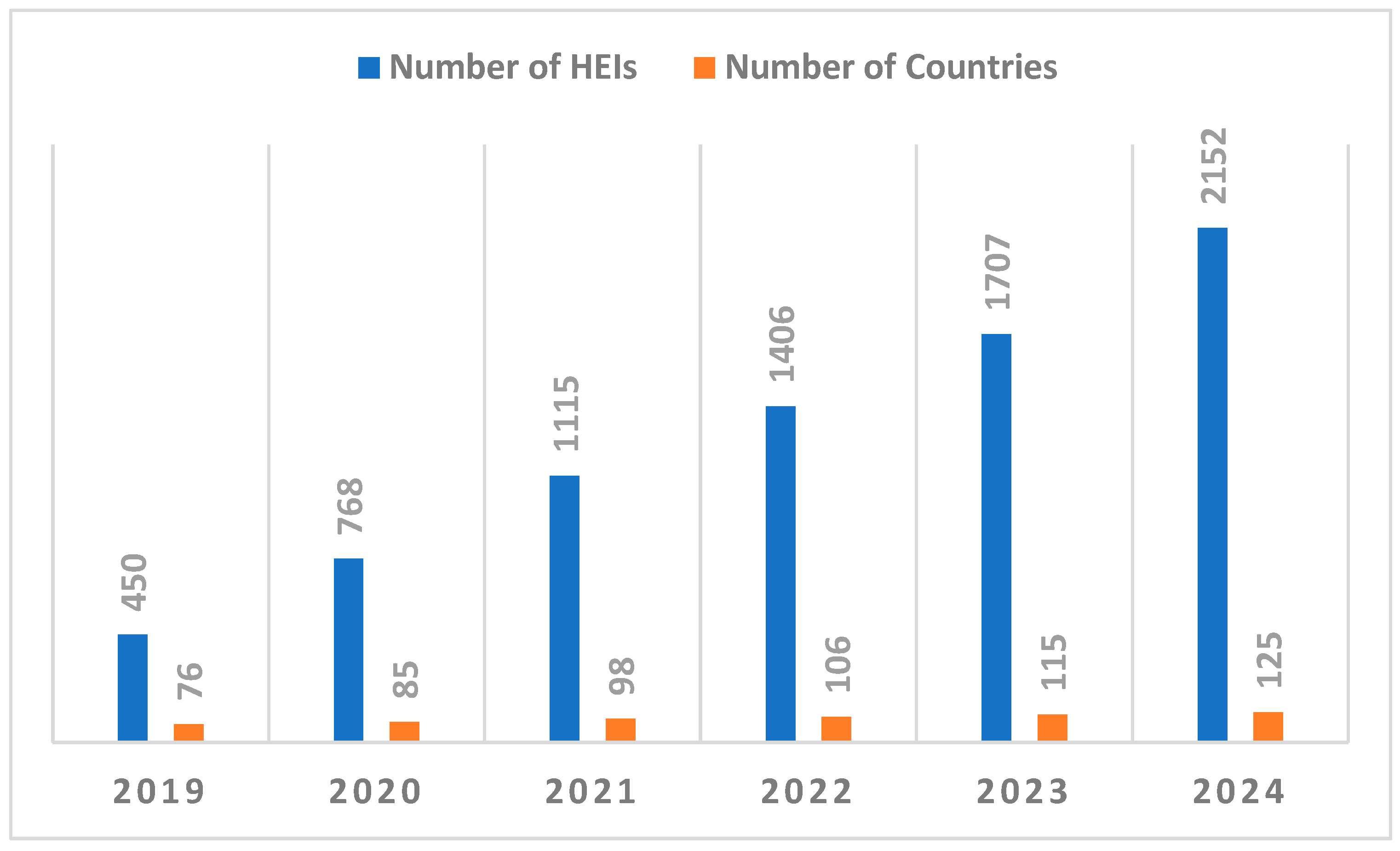
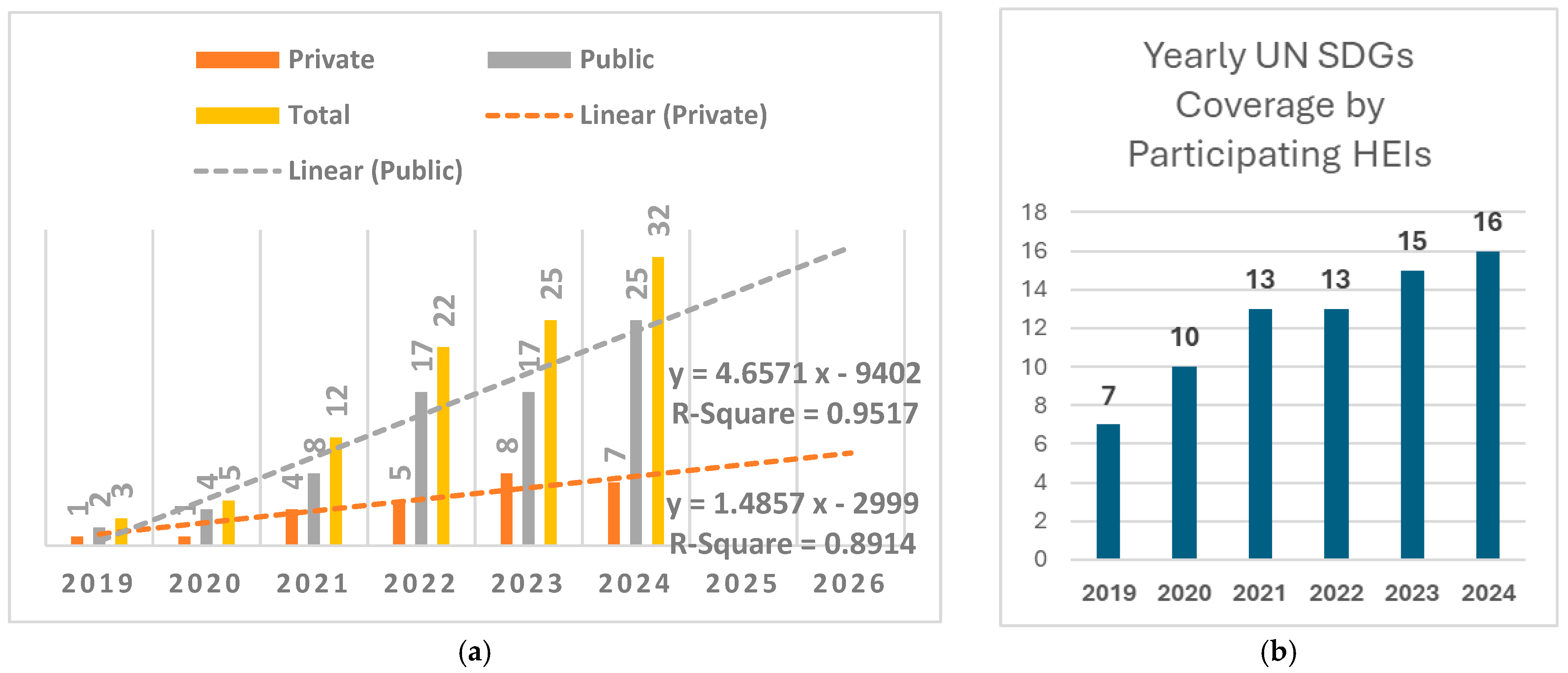
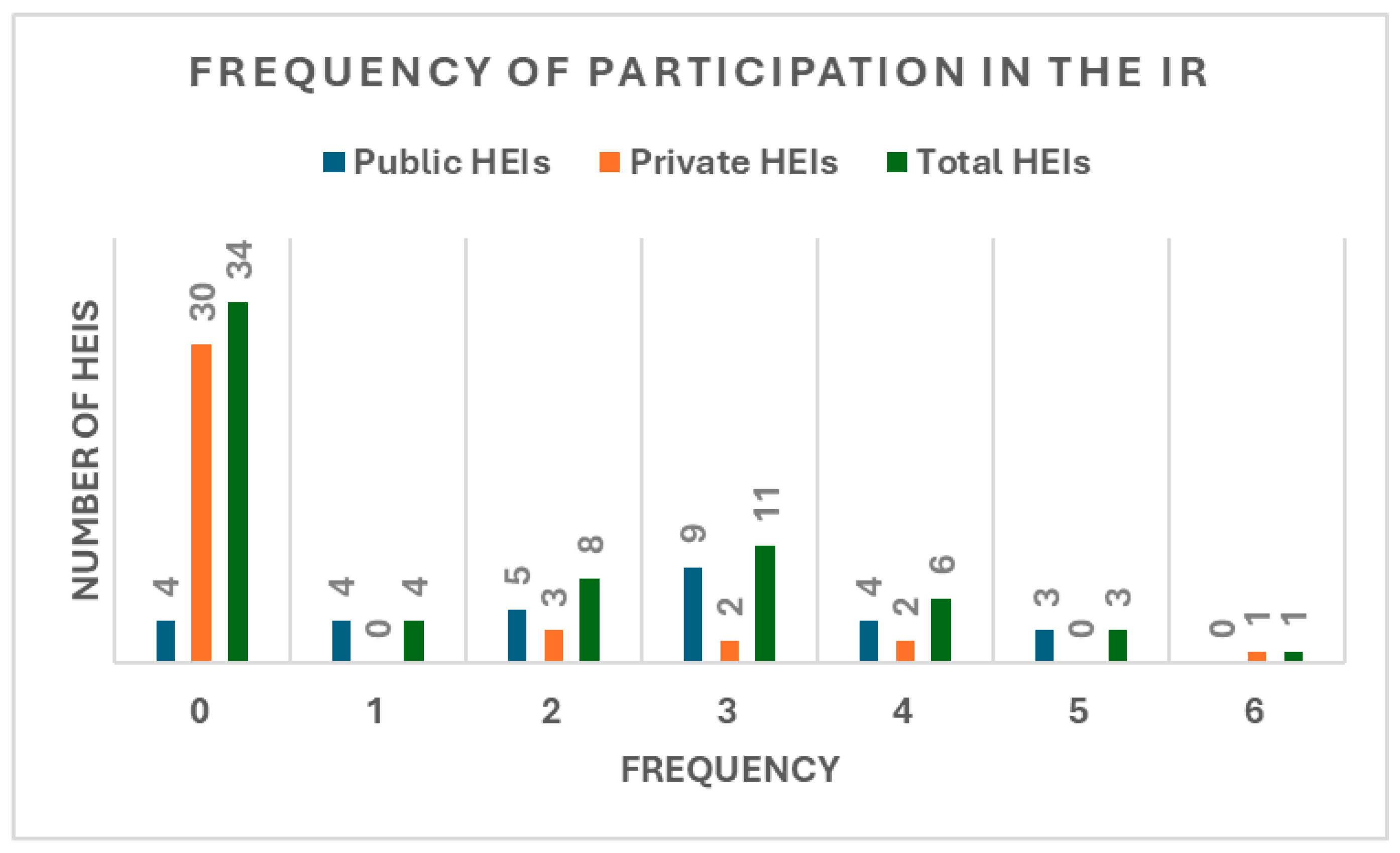

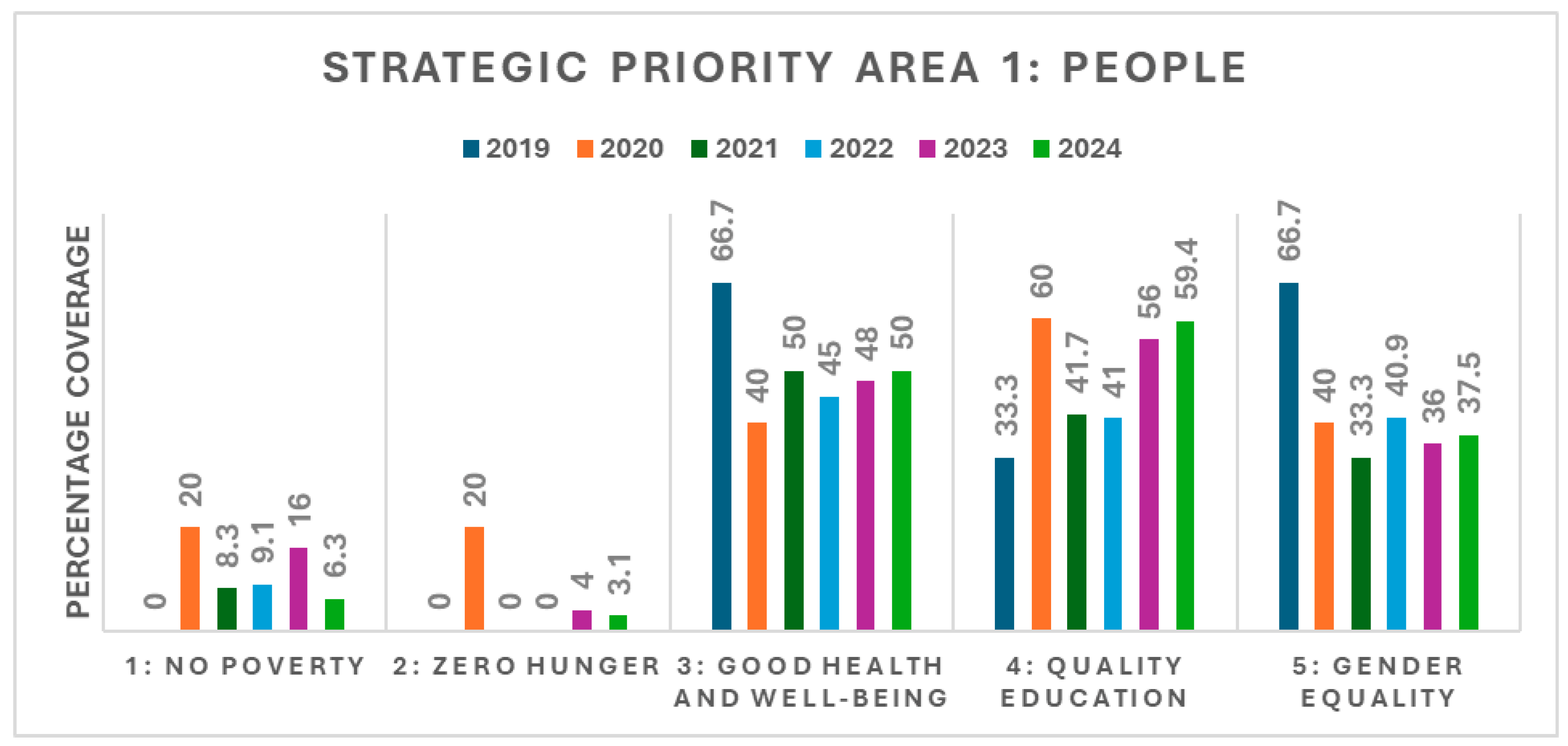
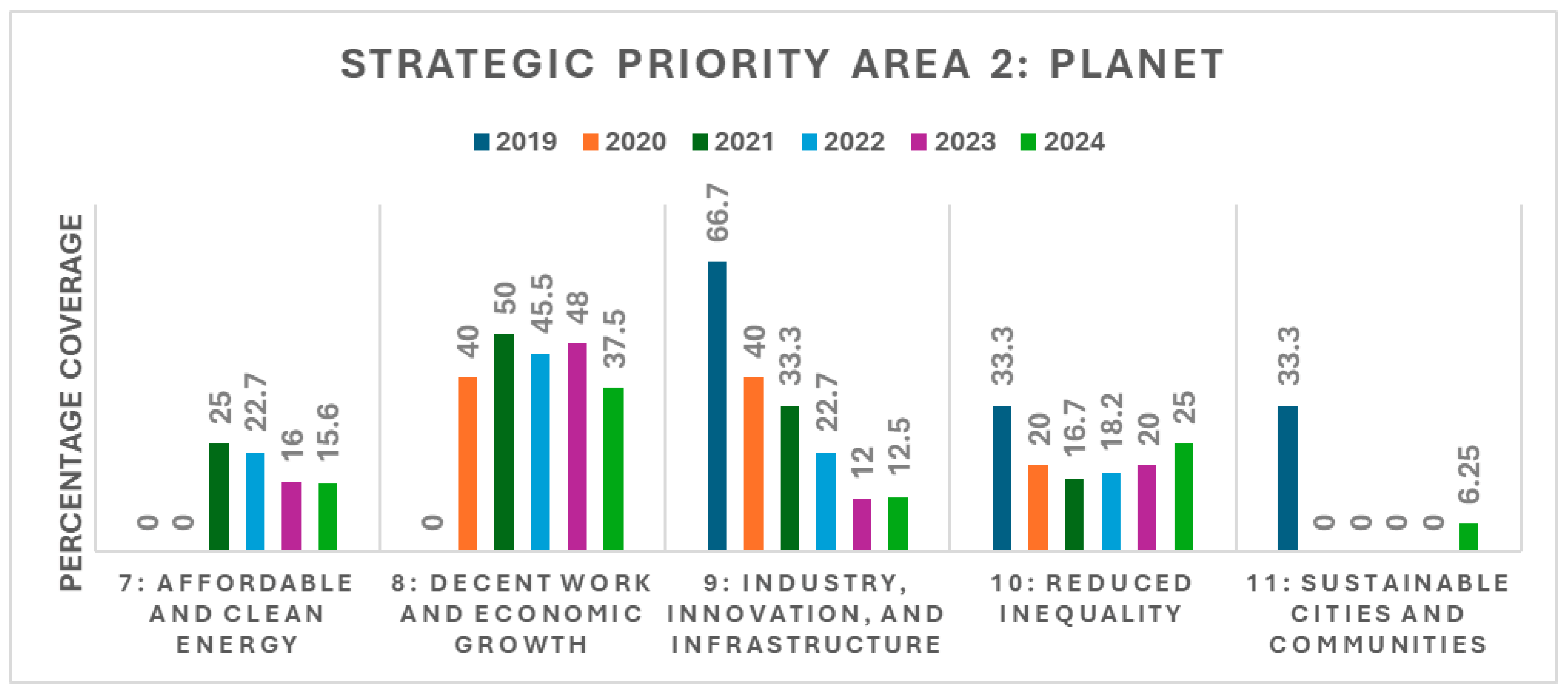
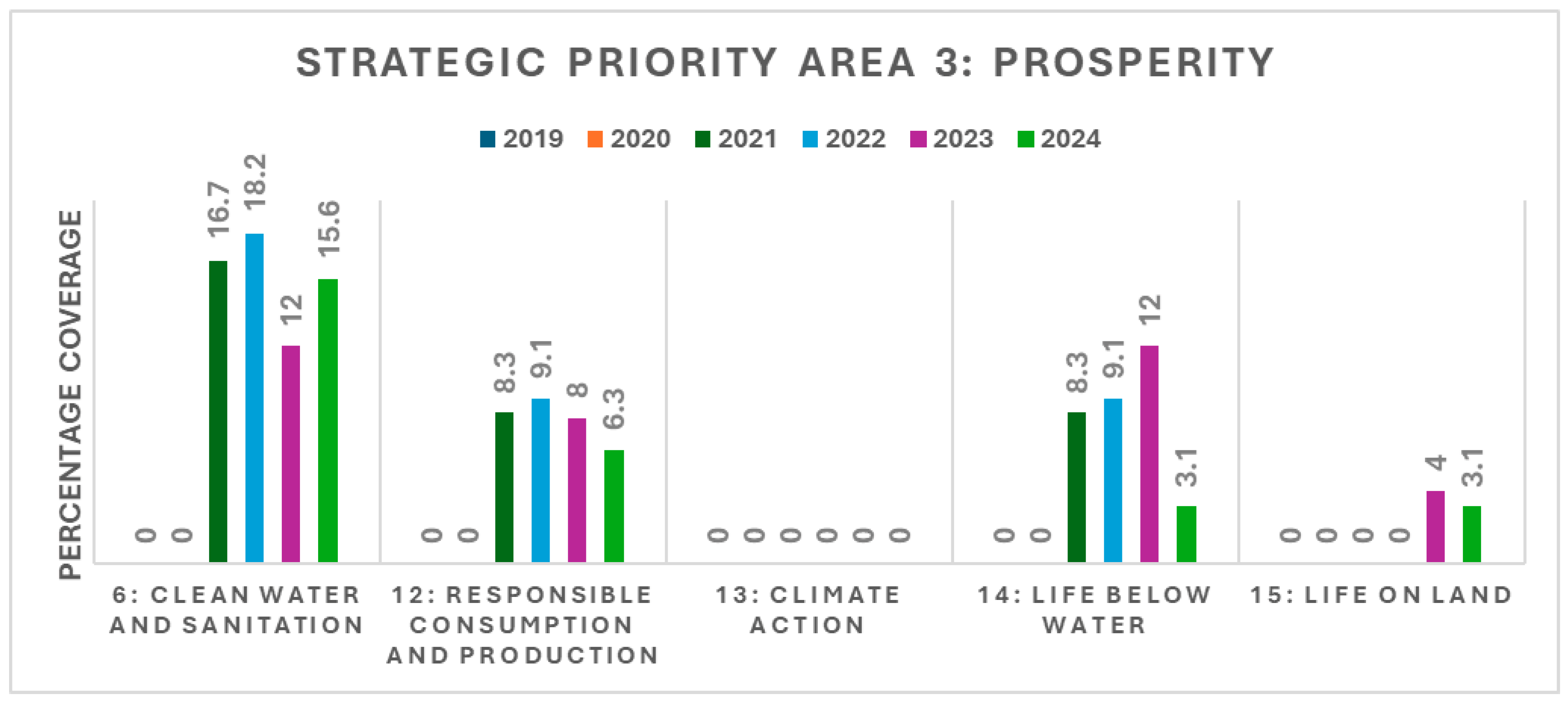
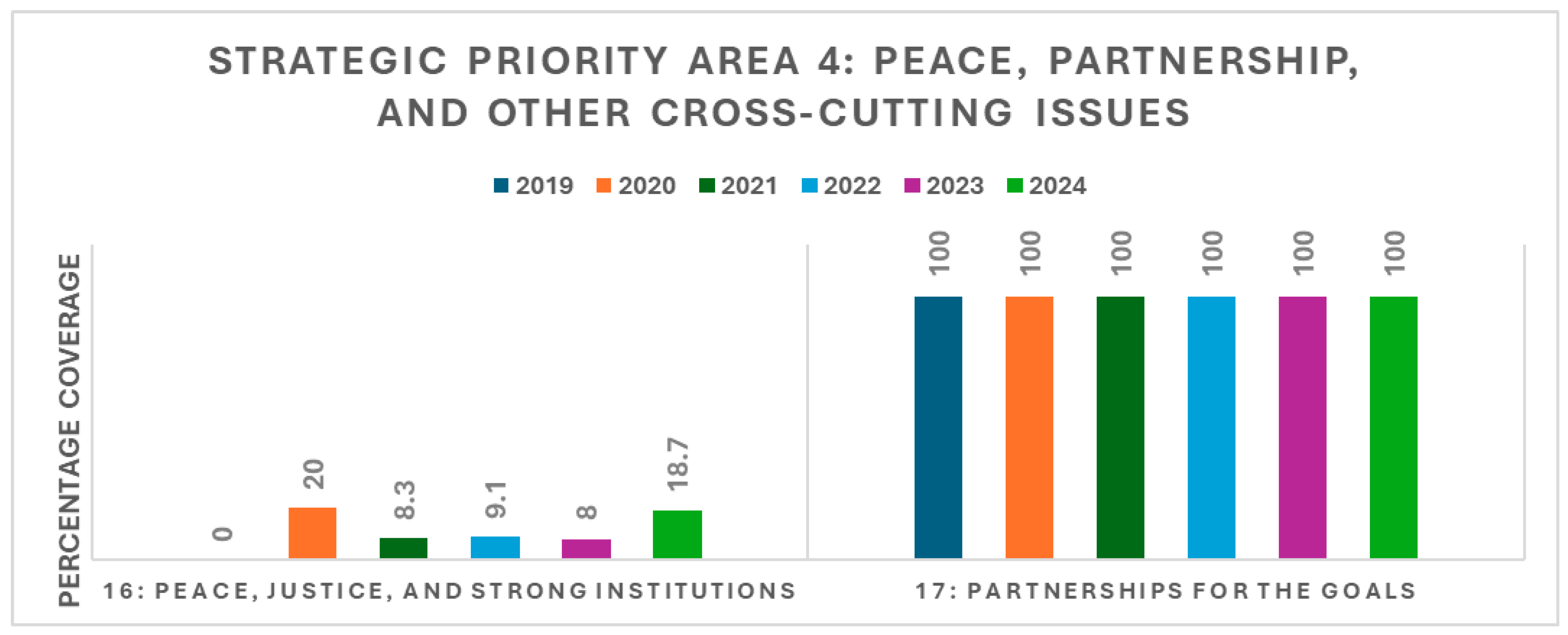


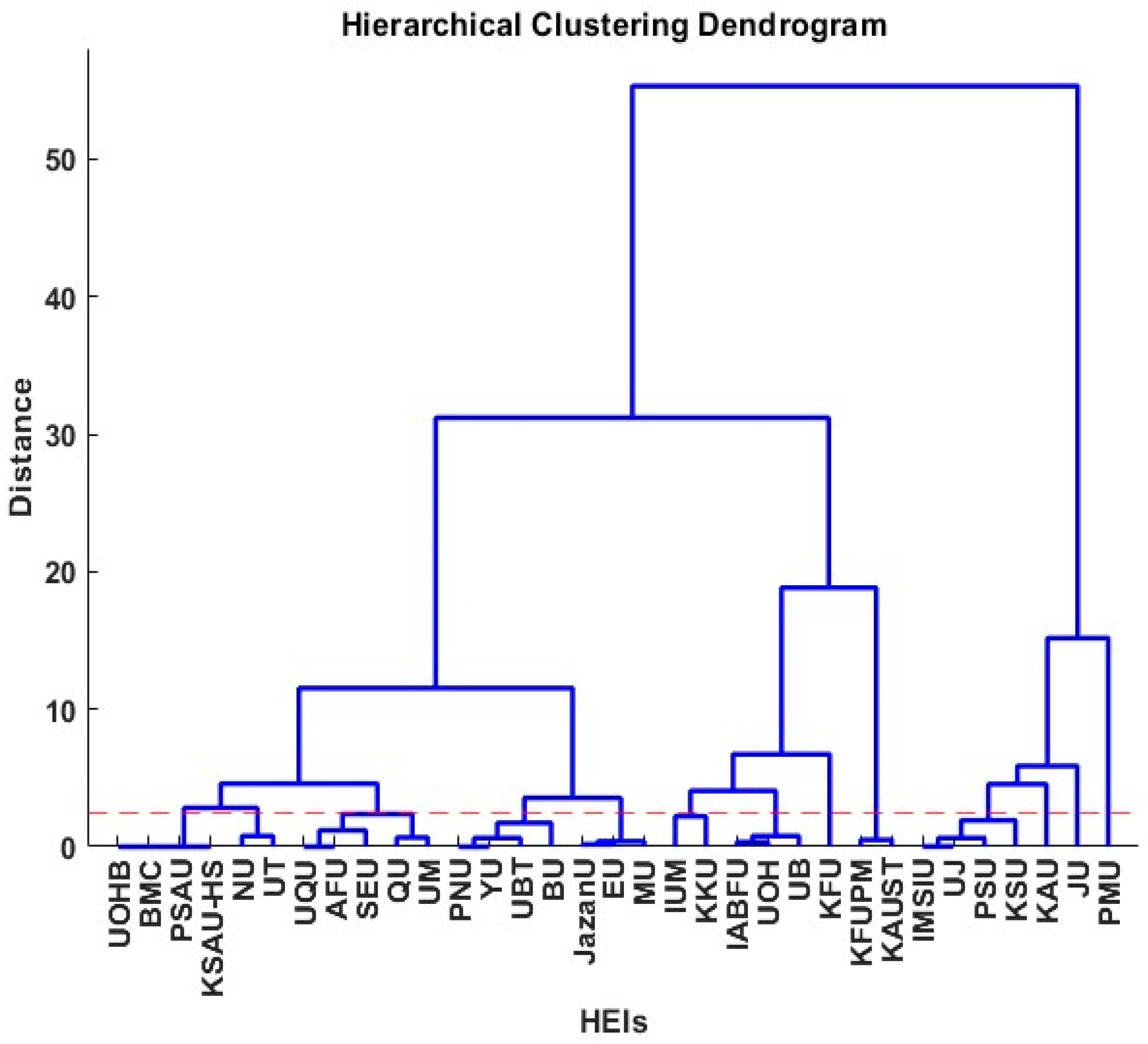
| Assessment Platform | Overview | Purpose | Regulatory Authority |
|---|---|---|---|
| [35] STAR, 2010 Sustainability Tracking, Assessment, and Rating System | A transparent, self-reporting framework for HEIs to measure their sustainability performance | To provide a self-reporting tool for assessing sustainability | Association for the Advancement of Sustainability in Higher Education (AASHE) |
| [36] UIGWUR, 2010 UI GreenMetric World University Ranking | Evaluates HEIs based on sustainability efforts | To rank universities globally by sustainability practices | University of Indonesia |
| [37] LIFE, 1992 Learning in Future Environments | Supports managing and improving sustainability in HEIs | To promote continuous improvement and social responsibility | Environmental Association for Universities and Colleges (EAUC), UK |
| [38] HESI, 2012 Higher Education Sustainability Initiative | Enhances HEIs role in advancing sustainable development globally | To promote sustainable development commitments by universities | Partnership between various UN bodies (launched at Rio+20) |
| [29] THE IR, 2019 Times Higher Education Impact Rankings | Assesses HEIs on teaching, research, stewardship, and outreach aligned with SDGs | To measure university societal impact through SDG metrics | Times Higher Education (THE) |
| [39] SET4HEI, 2024 Sustainability Evaluation Tool for Higher Education Institutions | An online resource for HEIs to map their contributions to SDGs | To help HEIs measure and improve their SDG impact | UNESCO IESALC in partnership with UNAI and other UN agencies |
| Sr. # | Public Sector HEI Name | Short Name | Frequency of Participation in THE IR | Established Year | Highest Achieved Ranking Band/Year |
|---|---|---|---|---|---|
| 1 | Umm Al-Qura University | UQU | 4 | 1950 | B3/2021 |
| 2 | Imam Muhammad bin Saud Islamic University | IMSIU | 3 | 1953 | B3/2022–2023 |
| 3 | King Saud University | KSU | 2 | 1957 | B2/2019 |
| 4 | Islamic University of Medina | IUM | 2 | 1961 | B4/2023–2024 |
| 5 | King Fahd University for Petroleum and Minerals | KFUPM | 4 | 1963 | B1/2024 |
| 6 | King Abdulaziz University | KAU | 5 | 1967 | B1/2019–2020, 2022 |
| 7 | Princess Nora bint Abdul Rahman University | PNU | 3 | 1970 | B1/20212 |
| 8 | Imam Abdulrahman Bin Faisal University | IABFU | 4 | 1975 | B2/2024 |
| 9 | King Faisal University | KFU | 4 | 1975 | B1/2024 |
| 10 | King Khalid University | KKU | 5 | 1998 | B3/2022 |
| 11 | Taibah University | TaibahU | 0 | 2003 | Not participated yet |
| 12 | Taif University | TU | 0 | 2004 | Not participated yet |
| 13 | Qassim University | QU | 5 | 2004 | B3/2024 |
| 14 | King Saud bin Abdulaziz University for Health Sciences | KSAU-HS | 1 | 2005 | B4/2024 |
| 15 | Al Jouf University | JU | 2 | 2005 | B3/2022 |
| 16 | Jazan University | JazanU | 1 | 2005 | B4/2024 |
| 17 | University of Hail | UOH | 3 | 2006 | B4/2024 |
| 18 | Al Baha University | BU | 3 | 2006 | B4/2024 |
| 19 | Najran University | NU | 2 | 2006 | B4/2023 |
| 20 | University of Tabuk | UT | 3 | 2006 | B4/2024 |
| 21 | Northern Borders University | NBU | 0 | 2007 | Not participated yet |
| 22 | Prince Sattam Bin Abdulaziz University | PSAU | 3 | 2008 | B4/2022 |
| 23 | King Abdullah University of Science and Technology | KAUST | 3 | 2009 | B2/2022–2023 |
| 24 | Majmaah University | MU | 1 | 2010 | B4/2024 |
| 25 | Shaqra University | SU | 0 | 2010 | Not participated yet |
| 26 | Saudi Electronic University | SEU | 3 | 2011 | B3/2022 |
| 27 | University of Bisha | UB | 2 | 2014 | B4/2023 |
| 28 | University of Hafr Albatin | UOHB | 1 | 2014 | B4/2024 |
| 29 | University of Jeddah | UJ | 3 | 2014 | B4/2023 |
| Sr. # | Private Sector HEI Name | Short Name | Participation Frequency | Founding Year | Highest Achieved Ranking Band/Year |
|---|---|---|---|---|---|
| 1 | Prince Sultan University | PSU | 4 | 1998 | B3/2022 |
| 2 | Effat University | EU | 2 | 1999 | B4/2024 |
| 3 | University of Business and Technology | UBT | 3 | 2000 | B4/2022 |
| 4 | Al Yamamah University | YU | 2 | 2001 | B4/2023 |
| 5 | Alfaisal University | AFU | 6 | 2002 | B2/2019 |
| 6 | Batterjee Medical College | BMC | 2 | 2005 | B4/2023 |
| 7 | Prince Mohammad Bin Fahd University | PMU | 3 | 2006 | B2/2023–2024 |
| 8 | AlMaarefa University | UM | 4 | 2009 | B3/2022–2023 |
| Year | HEIs Name and Achieved Rank |
|---|---|
| 2019 | KAU (54th) |
| 2021 | KAU (46th), PNU (27th) |
| 2022 | KAU (4th) |
| 2024 | KFUPM (81st), KFU (99th) |
| HEIs Name | UN-SDGs Covered | ||||||||||||||||
|---|---|---|---|---|---|---|---|---|---|---|---|---|---|---|---|---|---|
| 1 | 2 | 3 | 4 | 5 | 6 | 7 | 8 | 9 | 10 | 11 | 12 | 13 | 14 | 15 | 16 | 17 | |
| KAU | ✔ | ✔ | ✔ | ✔ | ✔ | ✔ | ✔ | ✔ | |||||||||
| PNU | ✔ | ✔ | ✔ | ✔ | ✔ | ||||||||||||
| KFUPM | ✔ | ✔ | ✔ | ✔ | ✔ | ✔ | |||||||||||
| KFU | ✔ | ✔ | ✔ | ✔ | ✔ | ✔ | ✔ | ✔ | ✔ | ||||||||
| Percentage coverage by participating HEIs | 25 | 25 | 0 | 75 | 50 | 50 | 50 | 100 | 50 | 50 | 50 | 25 | 0 | 25 | 0 | 25 | 100 |
| Cluster | No. of HEIs | Names of HEIs |
|---|---|---|
| 1 | 1 | KFU |
| 2 | 7 | PNU, JazanU, BU, MU, EU, UBT, YU |
| 3 | 1 | PMU |
| 4 | 2 | KFUPM, KAUST |
| 5 | 5 | IUM, IABFU, KKU, UOH, UB |
| 6 | 11 | UQU, QU, KSAU-HS, NU, UT, PSAU, SEU, UOHB, AFU, BMC, UM |
| 7 | 6 | IMSIU, KSU, KAU, JU, UJ, PSU |
| SDG | Lead HEIs | Role | Potential Group Members | Desired Action |
|---|---|---|---|---|
| 1 | KFU, UM | Pioneering | UOH, KKU, IMSIU, QU, NU | A pioneering role is demanded from both KFU and UM nationwide, even though there are no data to measure progress (SDR-2024, KSA [5]). |
| 2 | KFU | Seek more collaborators, strengthen and lead | KKU | Opportunity for all HEIs, with a specific invitation to private sector HEIs, as they have not yet addressed this SDG. |
| 3 | AFU, IABFU | Strengthen and lead | UQU, PSAU, BMC, BU, UB, KSAU-HS, UOHB, JazanU | There is a clear opportunity for a strong Public–Private HEI partnership, as these SDGs are extensively targeted by both public and private sector HEIs. HEIs should leverage this strength to qualify for the top-tier ranking band B1. SDG-5 demands a pioneering role from PNU, taking the forefront, initiating actions, and making a significant impact. |
| 4 | QU, AFU | Strengthen and lead | UQU, UT, SEU, IUM, BMC, PSAU, KSAU-HS, NU, UB | |
| 5 | PNU, PSU | Pioneering | EU, UBT, UJ, JazanU, MU, KSAU-HS, PSAU, UOHB | |
| 6 | KAUST, PMU | Pioneering | KFU, KKU, KFUPM, QU | KAUST must play a pioneering role, utilizing potential strong group members. |
| 7 | KFU, KKU | Benchmarked | KFUPM, KAUST, IABFU, JU, UOH, UB | Opportunity for impactful partnerships. All four B1 HEIs are listed. |
| 8 | PNU, UM | Benchmarked | KAU, IUM, PSU, UJ, UBT, BU, PMU, YU | |
| 9 | KAU, AFU | Benchmarked | KSU, KFUPM, UQU, UOH | |
| 10 | KAU, UBT | Benchmarked | PNU, BU, MU, SEU, EU, YU, PMU, JazanU | A strong group must address the data availability gap under the leadership of KAU through proper planning and initiatives (SDR-2024, KSA [50]). |
| 11 | KAU | Strengthen and lead | KSU, KAUST | Become sustainable campuses. Target SCI [53]. Demand more HEIs on board. Opportunity for all HEIs. |
| 12 | KFU, PMU | Strengthen and lead | IUM, SEU | |
| 13 | not covered yet | Invitation and opportunity for all HEIs. | ||
| 14 | KFUPM, PMU | Seek more collaborators, strengthen and lead | KAUST | Joint Research Ventures with NEOM (Red Sea). Demand more HEIs on board. |
| 15 | UT | Seek more collaborators, strengthen and lead | None | Opportunity for all HEIs. |
| 16 | KAU, PSU | Strengthen and lead | IMISU, KSU, JU, UJ, PMU | There is a clear opportunity for a strong Public–Private HEI partnership. |
| 17 | Mandatory SDG covered by all HEIs | |||
Disclaimer/Publisher’s Note: The statements, opinions and data contained in all publications are solely those of the individual author(s) and contributor(s) and not of MDPI and/or the editor(s). MDPI and/or the editor(s) disclaim responsibility for any injury to people or property resulting from any ideas, methods, instructions or products referred to in the content. |
© 2025 by the author. Licensee MDPI, Basel, Switzerland. This article is an open access article distributed under the terms and conditions of the Creative Commons Attribution (CC BY) license (https://creativecommons.org/licenses/by/4.0/).
Share and Cite
Wajid, H.A. The Role of Saudi Arabian Higher Education Institutions in Sustainable Development: Participation, Framework Alignment, and Strategic Insights. Sustainability 2025, 17, 2530. https://doi.org/10.3390/su17062530
Wajid HA. The Role of Saudi Arabian Higher Education Institutions in Sustainable Development: Participation, Framework Alignment, and Strategic Insights. Sustainability. 2025; 17(6):2530. https://doi.org/10.3390/su17062530
Chicago/Turabian StyleWajid, Hafiz Abdul. 2025. "The Role of Saudi Arabian Higher Education Institutions in Sustainable Development: Participation, Framework Alignment, and Strategic Insights" Sustainability 17, no. 6: 2530. https://doi.org/10.3390/su17062530
APA StyleWajid, H. A. (2025). The Role of Saudi Arabian Higher Education Institutions in Sustainable Development: Participation, Framework Alignment, and Strategic Insights. Sustainability, 17(6), 2530. https://doi.org/10.3390/su17062530






